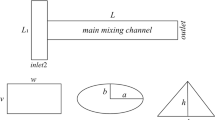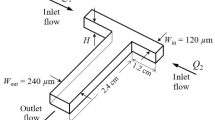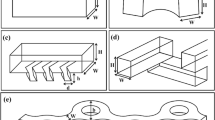Abstract
In this paper, a brief discussion on microfluidic devices and micromixer were made to clarify the difficult issues and category thus encountered. Based on Taylor dispersion mechanism, a new kind of micromixing pattern was investigated. Theoretical hydrodynamics model was established to characterize the Taylor dispersion behavior of the micro fluid. Numerical simulation and parametric evaluation were performed on the micromixing pattern enabled by the time-interleaved segmentation feeding of fluid. And good mixing efficiency was obtained. The present research is expected to be of important reference for better understanding the Taylor micromixing process. The corresponding method thus developed can serve as a useful tool for designing future micromixer.
Similar content being viewed by others
References
Fu LM, Yang RJ, Lin CH, et al. (2005) A novel microfluidic mixer utilizing electrokinetic driving forces under low switching frequency. Electrophoresis 5:1814–1824
John T, Mezić I (2007) Maximizing mixing and alignment of orientable particles for reaction enhancement. Phys Fluids 19:123602
Khatavkar VV, Anderson PD, Toonder JMJ, et al. (2007) Active micromixer based on artificial cilia. Phys Fluids 19:083605
Melin J, Giménez G, Roxhed N, et al. (2004) A fast passive and planar liquid sample micromixer. Lab Chip 4:214–219
Kim DJ, Oh HJ, Park TH, et al. (2005) An easily integrative and efficient micromixer and its application to the spectroscopic detection of glucose-catalyst reactions. The Analyst 130:293–298
Wu HY, Liu CH (2005) A novel electrokinetic micromixer. Sens Actuators A 118:107–115
Bisson C, Campbell J, Cheadle R, et al. (1998) A microanalytical device for the assessment of coagulation parameters in whole blood. In: Proceedings of the Solid-State Sensor and Actuator Workshop, Hilton Head, SC, pp 1–6
Anderson RC, Bogdan GJ, Puski A, et al. (1998) Genetic analysis systems: improvements and methods. In: Proceedings of the Solid-State Sensor and Actuator Workshop, Hilton Head, SC, pp 7–10
Kockmann N, Kiefer T, Engler M, et al. (2006) Convective mixing and chemical reactions in microchannels with high flow rates. Sens Actuators B 117:495–508
Niu XZ, Liu LY, Wen WJ, et al. (2006) Active microfluidic mixer chip. Appl Phys Lett 88:153508
Howell PB, Mott DR, Fertig S, et al. (2005) A microfluidic mixer with grooves placed on the top and bottom of the channel. Lab Chip 5:524–530
Nguyen NT, Huang XY (2005) Mixing in microchannels based on hydrodynamic focusing and time-interleaved segmentation: modeling and experiment. Lab Chip 5:1320–1326
Deshmukh LD, Pisano AP (2000) Continous micromixer with pulsatile micropumps. Technical Digest of the IEEE Solid State Sensors and Actuator Workshop, Hilton Head Island, SC, USA, pp 73–76
Fujii T, Sando Y, Higashino K, et al. (2003) A plug and play microfluidic device. Lab Chip 3:193–197
Okamoto UT, Kitoh HO (2004) New methods for increasing productivity by using microreactors of planar pumping and alternating pumping types. Chem Eng J 101:57–63
Hong CC, Choi JW, Ahn CH (2004) A novel in-plane passive microfluidic mixer with modified Tesla structures. Lab Chip 4:109–113
Taylor GI (1953) Dispersion of soluble matter in solvent flowing slowly trough a tube. Proc R Soc London A 219:186–203
Taylor GI (1954) Conditions under which dispersion of a solute in a stream of solvent can be used to measure molecular diffusion. Proc R Soc London A 225:473–477
Aris R (1956) On the dispersion of a solute in a fluid flowing through a tube. Proc R Soc London A 235:67–77
Barton NG (1983) On the method of moments for solute dispersion. J Fluid Mech 126:205–218
Brenner H, Ewards DA (1993) Macrotransport Processes, 1st ed. Butterworth-Heinemann, Boston, MA
Manninen M, Taivassalo V, Kallio S (1996) On the mixture model for multiphase flow, VTT Publications 288, Technical Research Center of Finland
Author information
Authors and Affiliations
Corresponding author
Rights and permissions
About this article
Cite this article
Yang, Y., Liu, J. Numerical simulation on Taylor dispersion enabled micromixture . Forsch Ingenieurwes 72, 93–100 (2008). https://doi.org/10.1007/s10010-008-0071-2
Received:
Published:
Issue Date:
DOI: https://doi.org/10.1007/s10010-008-0071-2




